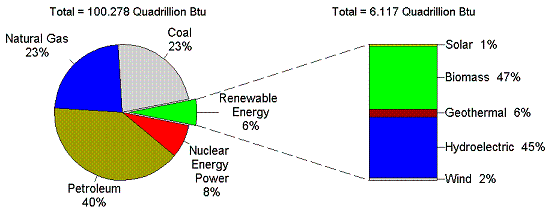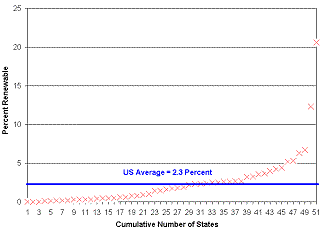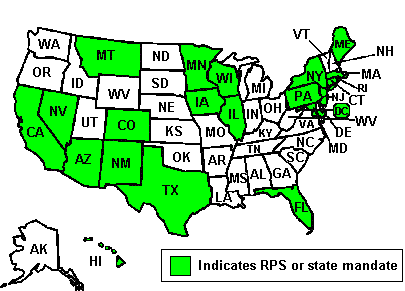Renewable Energy Trends 2004 Edition
Release Date: August 2005
Next Release Date: August 2006
Biomass Energy Consumption Revisions Electricity State Electricity
|
Renewable Energy Consumption Renewable energy consumption increased slightly less than 1 percent between 2003 and 2004 (Table 1).[1] At 6.1 quadrillion Btu, it provided a 6 percent market share of total U.S. energy consumption (Figure H1). Total energy consumption grew faster than did renewables, rising nearly 2 percent in 2004 to 100.3 quadrillion Btu.[2] Petroleum and natural gas supplied most of the increase. The electric power and industrial sectors continued to dominate renewable energy in 2004, although the transportation sector had the greatest year-to-year increase, 24 percent (Table 2). This was due to the expanding use of fuel ethanol to replace MTBE as this oxygenate is phased out in many states (Figure H2). Figure H1. The Role of Renewable Energy Consumption in the Nation’s Energy Supply, 2004 Source: Table 1 of this report. Total renewable energy consumption for electricity generation increased by 3 percent to 4.3 quadrillion Btu in 2004, despite a decline in conventional hydroelectric power (Table 3). Renewable energy consumption for nonelectric use (which includes useful thermal output at combined heat and power plants, space heating, and motor fuel) decreased by 4 percent to 1.8 quadrillion Btu (Table 4). Most of the decrease was in biomass energy for the residential and industrial sectors. Because of the importance of hydroelectric power, 70 percent of renewable energy was consumed for electricity generation, compared to 30 percent for nonelectric purposes. Biomass consumption increased by 4 percent, or 105 trillion Btu in 2004 (Table 6). Wood energy in the industrial sector and alcohol fuels in the transportation sector led the growth. Wood energy consumption in the residential sector declined due to a milder heating season. Biomass energy consumption was primarily from wood (70 percent) followed by waste (20 percent) and alcohol fuels (10 percent). Independent power producers were the biggest consumers of waste, using 240 trillion Btu of municipal solid waste and 59 trillion Btu of landfill gas in 2003 (Table 7). The role of electric utilities as consumers of waste energy was relatively minor; they used only 20 trillion Btu in 2003, down from 38 trillion Btu in 2002. While total U.S. industrial sector energy consumption grew 2 percent between 2003 and 2004 to 33,447 trillion Btu, industrial biomass energy consumption rose 6 percent to 1,620 trillion Btu.[3] Most industrial biomass energy consumption was black liquor and wood waste used by the lumber and paper and pulp industries for the production of “useful thermal output” (e.g. process heat and steam) to support their processes (Tables H3 and 8). Industrial biomass also includes (in lesser quantities) agricultural byproducts/crops, sludge waste, tires and others. Detailed information by industry and type of biomass energy consumed is provided in Table H3 for 2002 and Table 8 for 2003; there was little change between the years, except for the end-use. Energy for useful thermal output increased by 71 trillion Btu in 2003, while energy for electricity generation decreased by 103 trillion Btu. One hundred six electricity generating plants burned both biomass and coal in 2003 (Table 9). Plants for which biomass is only a small fraction of total energy consumption compared to coal are generally “co-fired” plants attempting to reduce emissions without making major retrofit investments. The remaining plants are dual- or multi-fired plants consuming fuels based on availability, demand and price. Figure H2. Ethanol and MTBE Consumption in the Transportation Sector 1992-2004 Source: Ethanol: Table 5 of this report. MTBE: 1992-2004: Energy Information Administration, Petroleum Supply Monthly DOE/EIA-0109 (Washington, D.C. Various Issues). Appendix D and Table 34, and Office of Coal, Nuclear, Electric and Alternate Fuels analysis.
Biomass Energy Consumption Revisions[back to top] Industrial Sector Every four years, the EIA conducts a survey of manufacturers, Form EIA-846 (A,B,C) “Manufacturing Energy Consumption Survey (MECS).” Between surveys, EIA estimates industrial biomass energy consumption based on the most recent MECS survey, industrial production indices, and other factors. Because data from the most recent MECS survey, for 2002, did not become available until late 2004, EIA initially estimated 2002 and 2003 industrial biomass energy consumption as described above. When EIA rebased its estimates for those years to the 2002 MECS survey, the revised estimates of consumption were notably lower. The new estimates for 2002 are presented in Table H1 along with estimates for 2003.
Some of the downward trend in 2002 compared to the last MECS in 1998 is due to the fact that wood production was down because the United States economy was in recession. Also, the paper and pulp industry is slowly replacing older equipment with newer, more efficient equipment. It is also worth noting that MECS is a sample. It is therefore possible that sampling error accounted for part of the downward revision. Table H3 presents detailed industrial biomass energy consumption by industry and fuel type for 2002 revised comparable to Table 8 for 2003. Transportation Sector EIA has revised the methodology used to estimate consumption of energy for alcohol fuels, principally fuel ethanol, so that the methodology across EIA is uniform. Previously, the Renewable Energy Annual and Renewable Energy Trends reports diverged from the Annual Energy Review (AER) and Monthly Energy Review(MER) and used the lower heating value of fuels which excludes the latent heat of evaporation. The revised estimates presented in this report assume the higher heating value, used in the AER and MER. Although energy from latent heat of evaporation is not normally used by engines in today’s vehicles, it is the full amount of energy available should a technology be developed in the future to harness it. In 2004, this revision resulted in a difference of 31 trillion Btu or an increase of about 11 percent (Table H2).
Electricity[back to top] Total U.S. electricity generation increased by 2 percent in 2004 to 3,953 billion kilowatthours.[4] In contrast, renewable electricity generation decreased 1 percent to 359 billion kilowatthours due to reductions in hydropower and biomass energy (Table 11). Wind power increased rapidly by 27 percent, but it still accounted for only 0.36 percent of the U.S. total. Electric power sector generation, including electric utilities and independent power producers, dominated production. Preliminary estimates of renewable electric capacity indicate there was a slight increase in capacity in 2004, though the change could be higher when EIA releases its final data (Table 12). The growth would probably have been greater but for the expiration of the Production Tax Credit (PTC) in December 2003. During much of 2004, the fate of the PTC was uncertain. The credit was finally renewed retrospectively in October 2004 as part of Public Law 108-311, “The Working Families Tax Relief Act of 2004,” but not in time for construction that year.[5] Early projections for 2005 were for rapid growth in wind to resume again until the next tax credit expiration date (December 31, 2005). The largest concentration (48 percent) of renewable electricity generation was in the Pacific Contiguous Census Division (Table 13). This division had the highest concentrations of hydroelectric, geothermal, wind, other biomass and solar power in the nation. Black liquor and wood/wood waste solids were the main energy sources for industrial sector biomass electricity generation and accounted for 63 percent and 32 percent of the sector’s total, respectively (Table 14). Twenty-three percent of the industrial sector biomass generation was from black liquor in the South Atlantic Division.
State Electricity[back to top] Growth in hydropower in California and the southeastern states led the increase in renewable generation in 2003, followed by other biomass in Florida and New Jersey and wind power in New Mexico, Washington, and West Virgina (Tables 17 and 20). Utility scale wind farms appeared for the first time in 2003 in Illinois, New Mexico, North Dakota, Ohio and Oklahoma (Tables 23 and 26). The major components of change in capacity were a nearly 1,600 MW expansion of wind, partially offset by a 660 MW decrease in hydroelectric capacity.
Figure H3. Renewable Electricity Generation Market Share by State, 2003 Source: Energy Information Administration, Form EIA-906, “Power Plant Report.” Overall, renewable electricity was 9 percent of total U.S. net generation; excluding hydropower, the share was only 2 percent (Table 27). Three northwestern states (Idaho, Oregon, and Washington) had more than 70 percent of their electricity provided by renewable energy, while 35 states had at least 3 percent (Table 27 and Figure H3). Excluding conventional hydropower, the number dropped to 13 states, led by Maine with 21 percent and California with 12 percent (Table 27 and Figure H4). Figure H4. Renewable Nonhydro Electricity Generation Market Share by State, 2003 Source: Energy Information Administration, Form EIA-906, “Power Plant Report.” By mid-2005, 22 states had renewable portfolio standards or state mandates (Table 28 and Figure H5). Maryland, Pennsylvania, Rhode Island, Washington, DC and Montana adopted renewable portfolio standards during 2004 and the first half of 2005. In addition, Hawaii’s voluntary standard established in 2001 was changed to an enforceable standard in 2004.
Figure H5. Renewable Portfolio Standards and State Mandates by State, 2005 (a) In Colorado and Florida the RPS is not statewide.
|
|||||||||||||||||||||||||||||||||||||||||||||||||||||||||||||||||||||||||||||||||||||||||||||||||||||||||||||||||||||||||||||||||||||||||||||||||||||||||||||||||||||||||||||||||||||||||||||||||||||||||||||||||||||||||||||||||||||||||||||||||||||||||||||||||||||||||||||||||||||||||||||||||||||||||||||||||||||||||||||||||||||||||||||||||||||||||||||||||||||||||||||||||||||||||||||||||||||||||||||||||||||||||||||||||||||||||||||||||||||||||||||||||||||||||||||||||||||
| Endnotes: [1] Note: Data in this report are shown for the most recent year available. For aggregate categories, this is preliminary 2004 data. For detailed categories, this is 2003 data and includes any revisions that were necessary. [2] Energy Information Administration, Monthly Energy Review April 2005, DOE/EIA-0035(2005/01) (Washington, DC, April 2005), Table 2.4, p. 31. [3] Energy Information Administration, Monthly Energy Review April 2005, DOE/EIA-0035(2005/01) (Washington, DC, April 2005), Table 2.4, p. 31. [4] Energy Information Administration, Monthly Energy Review April 2005, DOE/EIA-0035(2005/01) (Washington, DC, April 2005), Table 7.2a, p. 99. [5] American Wind Energy Association, Press Release for September 27, 2004. See website: http://www.awea.org/news/news040924wti.html. |
|||||||||||||||||||||||||||||||||||||||||||||||||||||||||||||||||||||||||||||||||||||||||||||||||||||||||||||||||||||||||||||||||||||||||||||||||||||||||||||||||||||||||||||||||||||||||||||||||||||||||||||||||||||||||||||||||||||||||||||||||||||||||||||||||||||||||||||||||||||||||||||||||||||||||||||||||||||||||||||||||||||||||||||||||||||||||||||||||||||||||||||||||||||||||||||||||||||||||||||||||||||||||||||||||||||||||||||||||||||||||||||||||||||||||||||||||||||
Contact: |
|||||||||||||||||||||||||||||||||||||||||||||||||||||||||||||||||||||||||||||||||||||||||||||||||||||||||||||||||||||||||||||||||||||||||||||||||||||||||||||||||||||||||||||||||||||||||||||||||||||||||||||||||||||||||||||||||||||||||||||||||||||||||||||||||||||||||||||||||||||||||||||||||||||||||||||||||||||||||||||||||||||||||||||||||||||||||||||||||||||||||||||||||||||||||||||||||||||||||||||||||||||||||||||||||||||||||||||||||||||||||||||||||||||||||||||||||||||
(entire report also available in printer-friendly format) 0.5MB ![]()
| Related Links | Format |
|---|---|
| About Us | html |
| Renewable Experts | html |
| FAQ | html |
| EIA Survey Forms | html |
| EIA Electricity Databases | html |
| State Energy Offices | html |
| Publications | html |
| Glosssary | html |
| Renewable Energy Websites | html |




